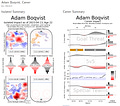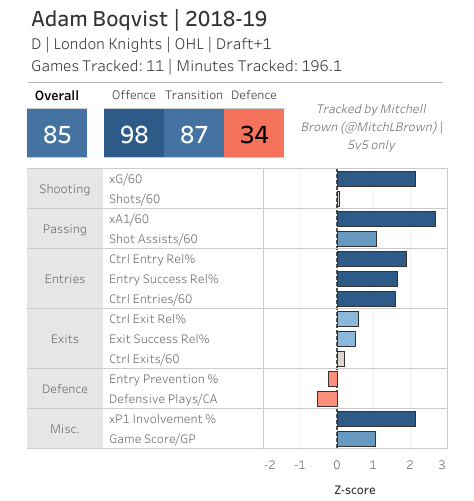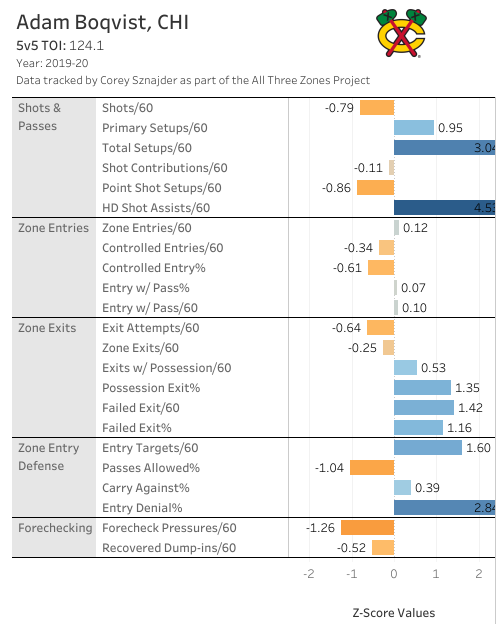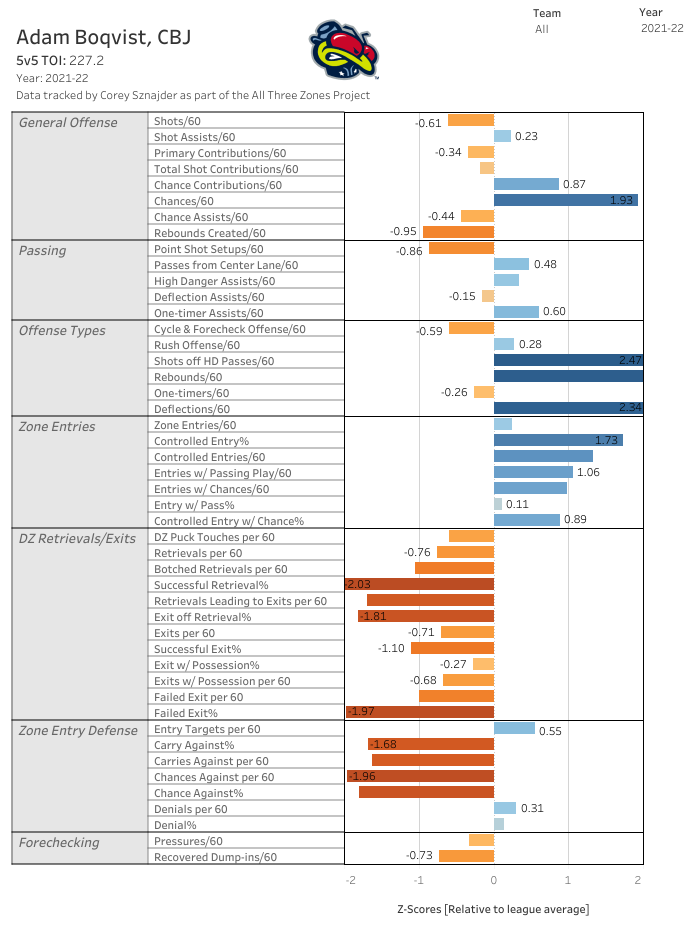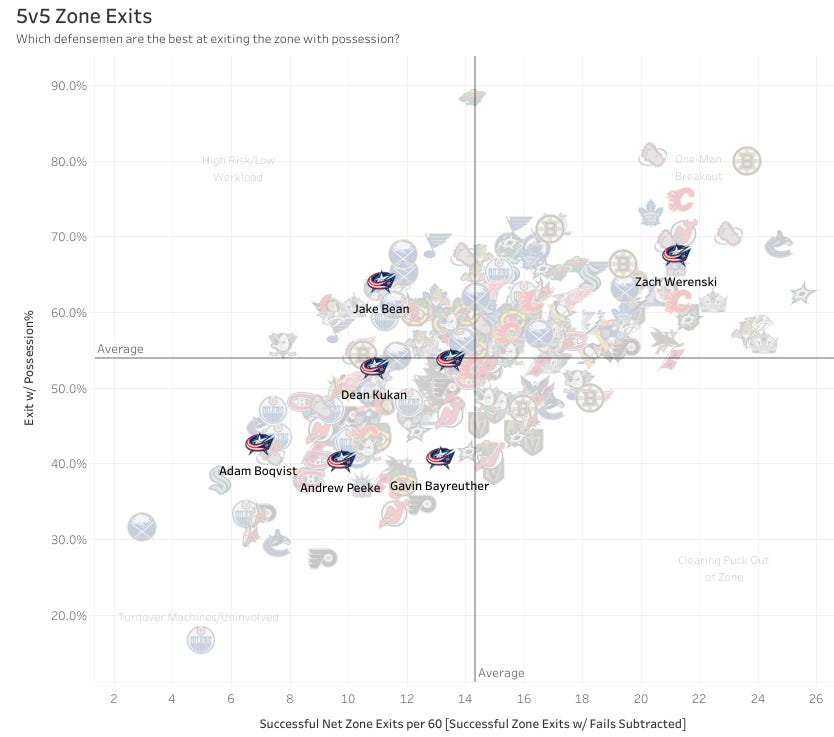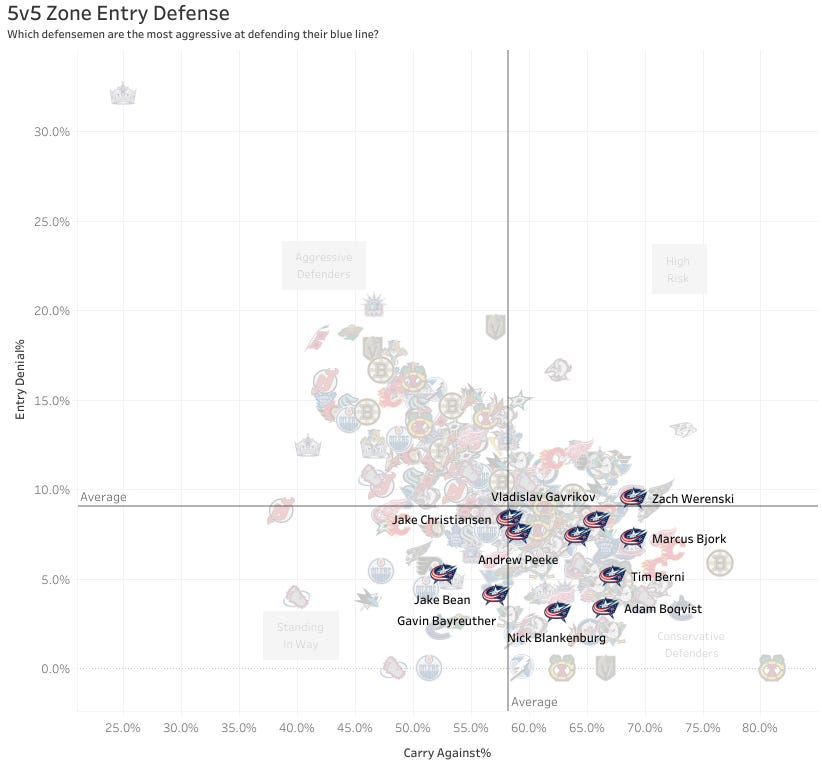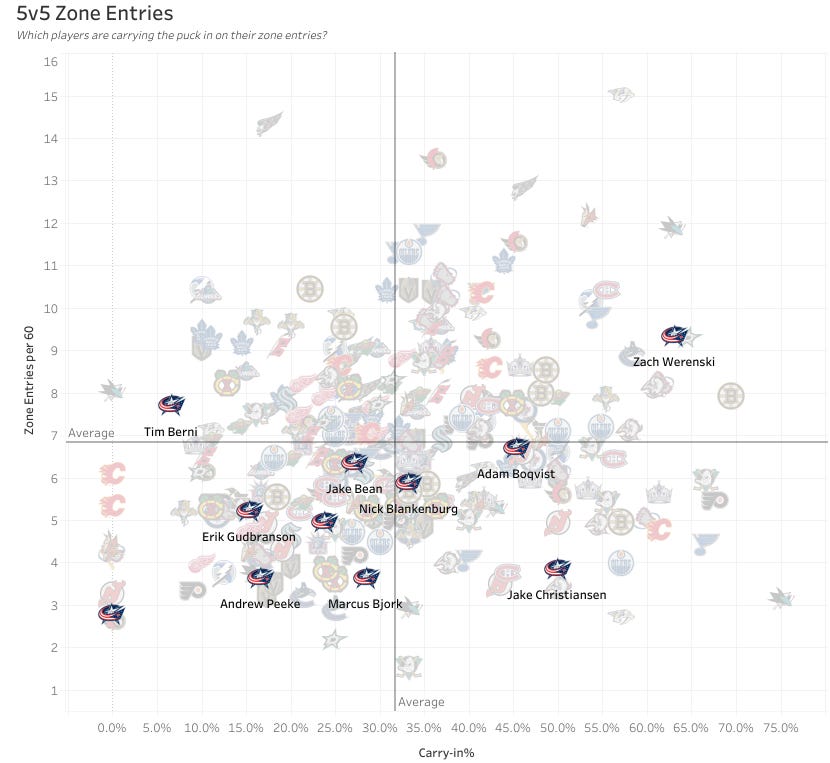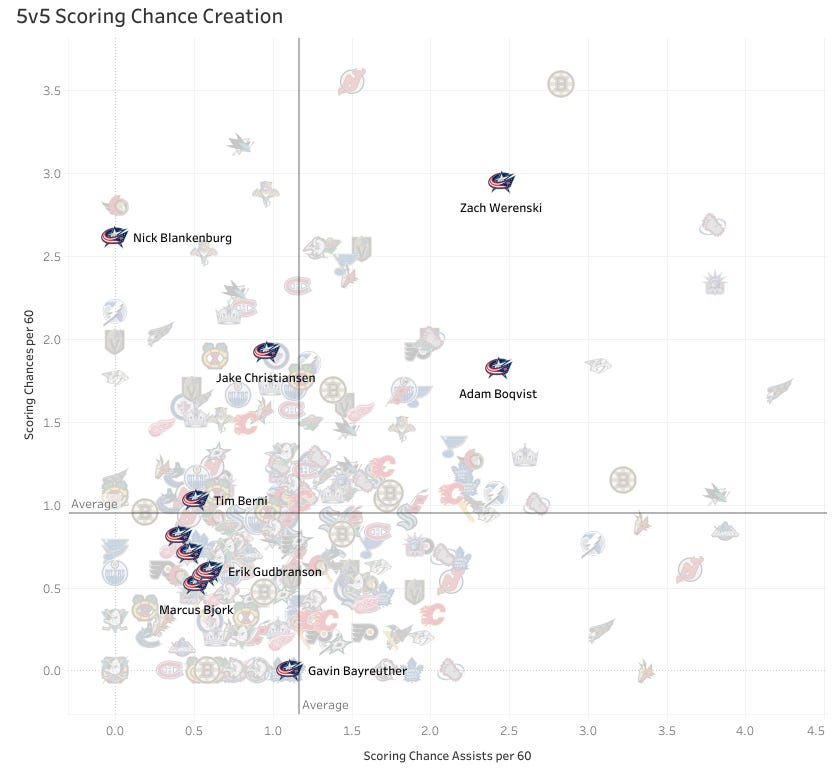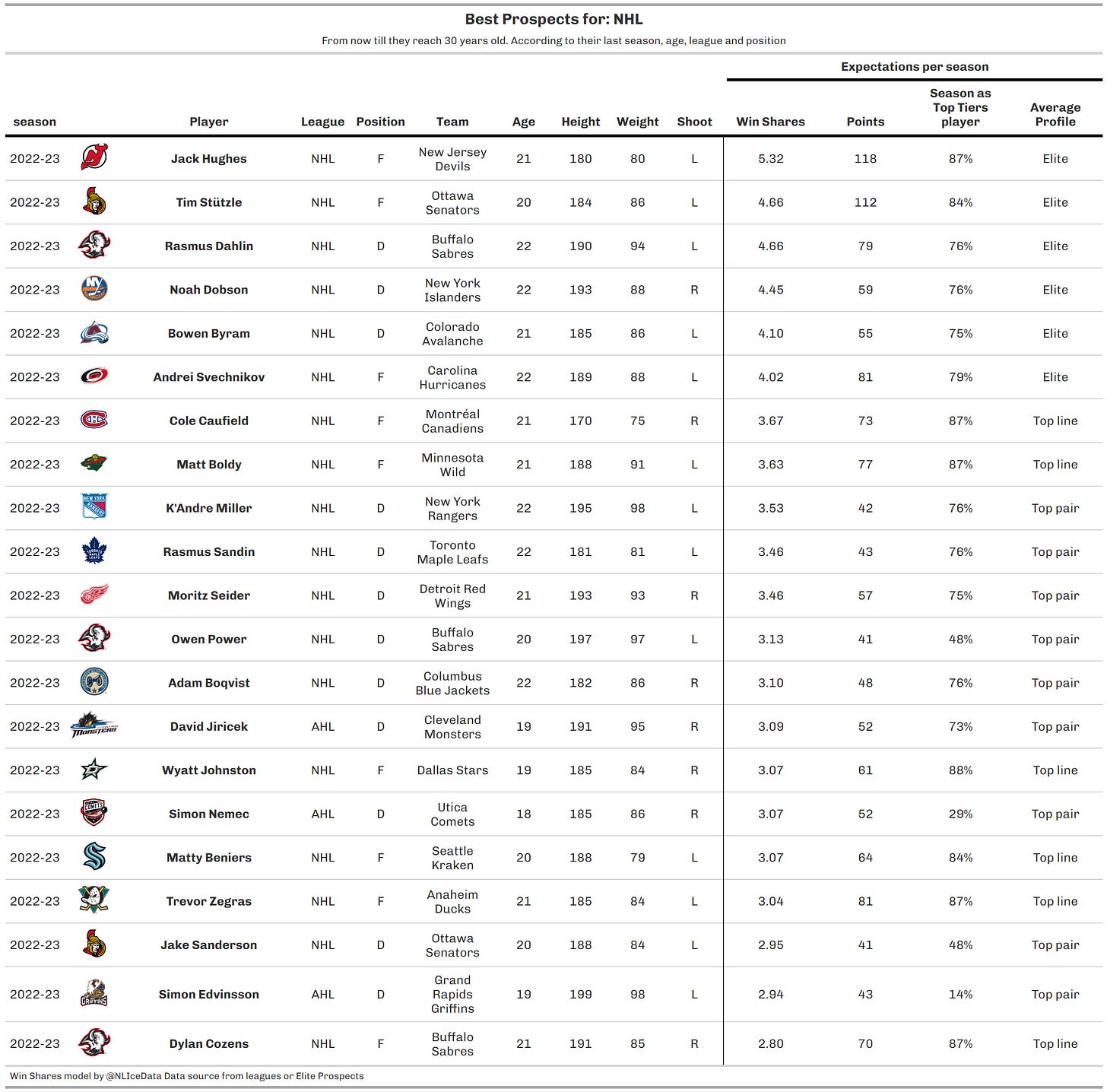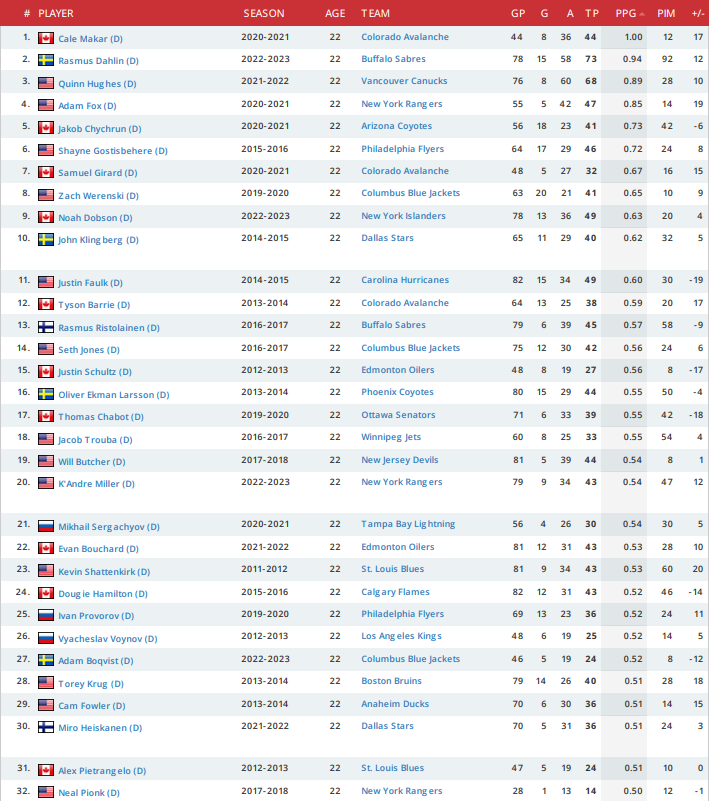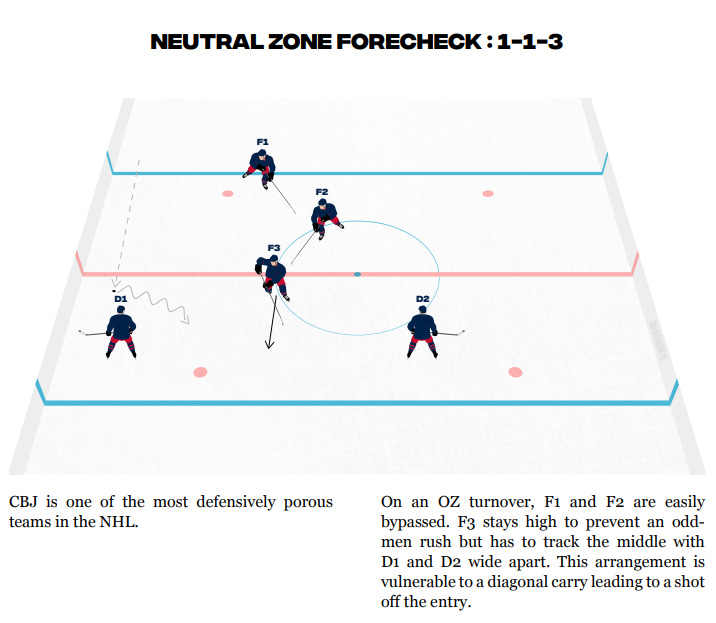What do the Blue Jackets have in Adam Boqvist?
A development retrospective using years of tracking data on the young Blue Jackets Defenseman
Adam Boqvist was one of the first pieces acquired as the Blue Jackets began to retool their roster. Acquired from Chicago during the 2020 NHL draft in the infamous Seth Jones trade, he hasn’t had the impact that many would have liked from a former 8OA pick.
As the retool reaches it’s next stage of competitiveness, especially after the firing of Brad Larsen, the drafting of Adam Fantilli and David Jiricek, and the signing of Damon Severson, Adam Boqvist could be getting squeezed out of the roster.
The question remains, should Adam Boqvist be part of the Blue Jackets’ defense plans going forward?
Development
Mitch Brown learned some lessons after doing quite a few NHL prospect retrospectives at EPRinkside.com,
Decision-making and play selection are the most common areas of improvement.
Players rarely develop brand-new ways to create post-draft, but they do repurpose and adapt.
Understanding the environment is part of understanding the player.
Edges are more predictive of future skating growth than mechanics.
Individual skill alone is rarely enough, but neither is an NHL style of play.
Project for where the game’s headed, not where it is.
Some of these lessons will apply more than others in this retrospective, but it remains a good guidepost for examining Boqvist’s career up to this point.
Junior
If players rarely develop new ways to create post-draft, it’s going to behoove us to examine what exactly Boqvist looked like prior to hearing his name called by the Blackhawks in 2019.
Adam Boqvist played his draft year split between the SHL and J20 Nationell, the top junior league in Sweden. He performed well enough there to be drafted 8OA by the Chicago Blackhawks. Then, he moved to the London Knights for his D+1 year.
Few draft eligible defensemen get playing time in the SHL, so while there is a lot of red on the card, the blues do stand out. He sees the ice well and has the capacity to hit the players he finds. He graded out very well in transition despite being quite horrendous at exiting the zone, something we’ll see more of later. Even in the SHL, playing amongst men, Boqvist remained an average defensive player in the neutral zone.
Here, we see Boqvist step up to dominate the neutral zone with the puck on his stick while still struggling at getting the puck out of the zone. His defensive play declined but his offensive impact was dramatic.
His low Shots/60 but high xG/60 suggests a player taking dangerous shots from high-value areas of the ice. His high xA1/60 but low Shot Assists/60 show that he’s being selective about passing and has the skill to hit the dangerous areas of the ice.
Here’s Curtis Joe’s take, available on Boqvist’s bio-page on EliteProspects.com,
A dynamic offensive defenceman that can carry plays with the puck on his stick. A highly mobile and nimble skater that moves with fluidity, balance, and confidence. Utilizes an active stick and creates turnovers frequently. Could be more proactive in his own end, but has shown progression in understanding lanes and reading unfolding plays; most of his best defensive work comes through the neutral zone, as there is a lot less time and space to work with, and it is in those moments that Boqvist shines.
Offensively, Boqvist is electric; he has the toolbox of a top line forward. Slick puckhandling ability paired with excellent vision and positional awareness makes him a dangerous threat every time he is on the ice. He also takes advantage of the attention and bodies he draws towards himself in creating space for teammates. All-in-all, Adam Boqvist is a complete offensive defenseman who knows how to get the puck from point A to the back of the net, and can make it happen all by himself. (Curtis Joe, EP 2017)
Here’s what we learned about the player that Boqvist was:
He isn’t good defensively
He can’t retrieve the puck and/or turn it into zone-exits
He is great at moving the puck through the neutral zone
He is a great passer
He shoots from dangerous areas
He prefers quality to quantity
NHL
Adam Boqvist’s first year in the league was his D+2, or Age 20, season. He was paired primarily with an aging Duncan Keith and was a surprisingly good neutral zone defender (low Carry Against% and high Entry Denial%) .
Offensively, he continued to prefer quality to quantity and only looked average at creating zone entries with possession.
When Boqvist joined the Columbus Blue Jackets, his defense really took a nosedive. He returned to his puck-carrying savvy through the neutral zone and continued to put up respectable passing numbers. He rediscovered his high-danger shooting, likely through the Blue Jackets’ encouragement of activating D in the offensive zone.
For the most part, we’ve seen it hold true that Players rarely develop brand-new ways to create post-draft, but they do repurpose and adapt.
Team Context
Because understanding the environment is part of understanding the player (and also because Boqvist doesn’t have an AllThreeZones playercard for 2022-2023) I’ll walk us through a deeper look at some of the key metrics that we’ve observed as strengths and weaknesses in Boqvist’s game.
Puck Moving
First, let’s start with his zone-exiting. The Blue Jackets love this from defenders. A weak in-zone defender can make up for their weakness by simply getting the puck out of the zone quickly and playing offense instead. Unfortunately, Brad Larsen’s Columbus Blue Jackets weren’t particularly proficient in this regard.
We’ve seen from his playercards that Adam Boqvist has always struggled in this regard, but having an idea of his performance in context can really drive the point home.
Adam Boqvist, in 2021-22, was one of the worst puck-movers in the NHL. We could see that clearly in his player-card but putting it into visual context does a lot of work for me. More on his 2022-2023 breakout data later.
Neutral Zone Defending
In 2022-2023, his neutral zone defense had all but disappeared with the Blue Jackets. However, the Blue Jackets as a whole struggled, with nearly all players being below league average in both aspects.
Offense
Despite his deficiencies in his own zone, Adam Boqvist remained one of the top defensemen on the Blue Jackets in creating entries with possession and one of the top defensemen in the league at creating scoring chances. Only 15 defensemen assisted on more scoring chances (shoutout new Blue Jacket Damon Severson as the New Jersey Devil in the bottom right) and only around 30 defensemen took more scoring chances than Boqvist.
Total Career Context
Adam Boqvist still looks like the player we saw in the AllThreeZones data. He’s good offensively and poor defensively. He accesses the middle of the ice to both shoot and pass. His shooting has improved and become a weapon at the NHL level and his passing game has finally matured to the level he showed in Juniors.
It appears that Boqvist has elevated his Junior game to the NHL level.
Since coming to the Blue Jackets, however, his defensive play has cratered. We know, from the AllThreeZones data, that a lot of this can be explained by poor play-killing in the neutral zone. More on that later as well.
Hope for the Future
NHLe and Projection
https://twitter.com/Thibaud_Chatel/status/1672314955633139714?s=20
Before the draft, Thibaud Chatel was working on a model to evaluate prospects (cut-off age 22) and how they are projected to perform from this season until they are Age 30. To my surprise, Adam Boqvist appeared as one of the best prospects in the NHL today.
It’s worth noting that the model is projecting him with some degree of certainty because he has already performed in the NHL. It might still be surprising to see him here, but you have to remember that he was drafted extremely young. He was an August birthday, only a month or so away from being eligible for the 2019 NHL draft. You can read more at the link below, Chatel is a great read because he isn’t afraid to share the details behind his models.
Still, it’s surprising to see Boqvist projected as a top pair defenseman who should average 48 points per season until age 30. This list, furthermore, is ranked by win-shares which attempts to factor in defensive play as well. Adam Boqvist barely feels like a prospect anymore, and truthfully he is barely a prospect, but him playing in the NHL for 4 years has certainly distorted many people’s perceptions of the player.
Adam Boqvist just put up the 27th most productive age-22 season by a defenceman since 2010. The players around him, even at their lows, had long NHL careers. The worst among the bunch are Shayne Gostisbehere, Will Butcher and Justin Schultz. It’s easy to see why a model would be incredibly optimistic about a player of Boqvist’s caliber.
Production is only one aspect of Boqvist’s story, so we’ll go ahead and take a look at some of the finer details with hand-tracked data.
Puck Moving
Remember that 2022-23 zone-exit data I hid from you? Well here’s why: In 2022-2023, Adam Boqvist finally took strides toward improving his breakout game. While he didn’t retrieve the puck enough to implant himself as a bona-fide puck-mover, he certainly took steps in the right direction. Relative to the rest of the Blue Jackets, Adam Boqvist was great at exiting the zone with possession.
While retrievals, and diffusing the pressure that comes from forecheckers, are one thing, Boqvist has always had the lateral vision and passing to be an excellent puck-mover. If 2022-23 is the beginning of a trend, it appears that Boqvist may be repurposing and adapting.
Teamwide Improvements
As the Blue Jackets move onto their next coaching staff, featuring at the very least head coach Mike Babcock, and an upgraded roster, Adam Boqvist will certainly have the opportunity to reclaim a few areas of his game that have all but disappeared since joining the Blue Jackets.
Using an excerpt from Jack Han’s excellent Hockey Tactics 2023, we can see surmise a few reasons CBJ, and Adam Boqvist, struggled with killing plays in the neutral zone and denying entries.
A weak neutral zone structure separated the defensemen and relied on F3 to take away the most important area of the ice. That, combined with CBJ’s injury decimated and otherwise inexperienced forward group, could be the leading reason that all Blue Jackets defensemen struggled to stop plays early. If Babcock brings more structure to the neutral zone, Boqvist could uncover the tight neutral zone game that has been long dormant.
I’ve written previously on the D corps improvements I’d like to see from the Columbus Blue Jackets. TL;DR: Teams like LA and Colorado created pairs based on a puck-retriever (Cale Makar or Drew Doughty) and an aggressive entry defender (Devon Toews and Mikey Anderson).
If Boqvist can indeed reclaim the neutral zone play-killing that made Curtis Joe so enthusiastic, he has a good shot to stay with the Blue Jackets as an excellent partner to their great retrieving lefty-defensemen currently on the Blue Jackets roster(Werenski and Provorov both).
In his first year with the Blue Jackets, Boqvist struggled with athletic engagement and was easily bypassed in both the neutral and defensive zones. This most recent year was improved but he’s still got a lot of lower-body strength to add. The good thing, here, is that he at least has a good skating base and added strength will only make him better in both the neutral zone and along the boards.
Projecting for the Future
It’s no secret that the Blue Jackets love active defensemen. Zach Werenski and Seth Jones were sorts of pioneers in this regard (along with Ryan Murray and Markus Nutivaara), at least for the hockey club. Since then, Jarmo has acquired Boqvist and Jake Bean while drafting Corson Ceulemans, Stanislav Svozil, Denton Mateychuk and David Jiricek, all of whom feature very active styles.
Here’s an excerpt from Mitch Brown’s previous retrospective, “Similarly, as the game becomes more focused on activation and full-team offence, it’s creating opportunities for skilled, proactive defenders to activate more and more.”
Boqvist is already an incredibly active defenseman. Without the puck he loves to move down in the offensive zone, shown by his propensity to shoot from dangerous areas, and he loves leading the rush.
Check out this goal from 2021.
Boqvist offers quick movement from the blueline, activates through the middle of the ice, and is rewarded with a goal from a dangerous area.
Chemistry with Zach Werenski
In an interview with Bailey Johnson of the Columbus Dispatch, Werenski had the following to say about Adam Boqvist
"I think it’s definitely easier playing with a righty, just naturally," Werenski said. "Your forehands are facing each other. There’s some guys that can play the right side as lefties and vice-versa and they’re good at it, but I think just naturally, playing with a righty is ideal. Bo’s a really good hockey player. I like playing with Bo. It’s tough now because I didn’t play all season, so those sample sizes are small, but I think we’ve seen what Bo can do and how he sees the game.”
The numbers back it up. Werenski has been paired with only 3 defensemen for more than 100 minutes over the course of the last two seasons. Andrew Peeke, Jake Bean and Adam Boqvist. Of those three pairs, Werenski and Boqvist posted a 57.38 CF% and a 54.8 xGF%. The other two were below 50% in both aspects (47.09 CF%/49.14CF%, 45.73xGF%/45.68xGF%, respectively).
It is worth mentioning that Blankenburg and Werenski have had excellent results in a small sample size as well, though Blankenburg also suffers from some of the same issues as Boqvist.
The Injury Problem
In order for Adam Boqvist to continue earning a spot with the Columbus Blue Jackets, he has to stay healthy. Although he wasn’t the most egregious offender this past year, he hasn’t played more than 52 games in an NHL season yet in his career.
His concussion history is absolutely a concern, not just for his performance on the ice but also for his well-being after his career has ended. With luck, Boqvist can shake the injury bug and become a valuable offensive defenseman for the Columbus Blue Jackets.
Market Value
As mentioned before, the Blue Jackets have a massive jam on the right-side of the ice which may only intensify if David Jiricek proves himself ready for an NHL roster spot. If Boqvist is the player to go, the Blue Jackets should be looking to get good value of this young and talented, but flawed, asset.
While examining his historic production within context of other defenseman, we can see that many in his scoring cohort have gone on to play roles on Stanley Cup contenders. Defenseman like Tyson Barrie, Evan Bouchard, Kevin Shattenkirk and Justin Schultz have held down spots despite struggling defensively and/or producing primarily on the powerplay.
If Boqvist improves little, there is still a market for a defenseman of his type across the league.
Furthermore, of his production cohort, Rasmus Sandin was most recently traded for a 2023 1st round pick from the Washington Capitals. In the past, Kevin Shattenkirk was traded at the 2017 deadline (along with Pheonix Copley) to the contending Washington Capitals for a 1st round pick, a performance conditional 2nd round pick, Brad Malone’s contract and Zachary Sanford. Tyson Barrie was traded as a package for Nazem Kadri.
If the Blue Jackets decide to move on from this young defenseman, they should be, at the very least, returning a first round pick or using him in a package for an upgrade elsewhere.

